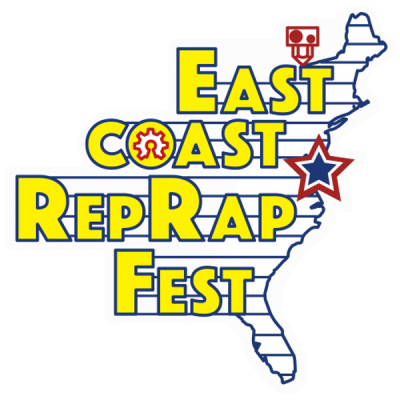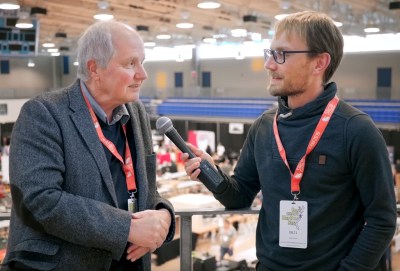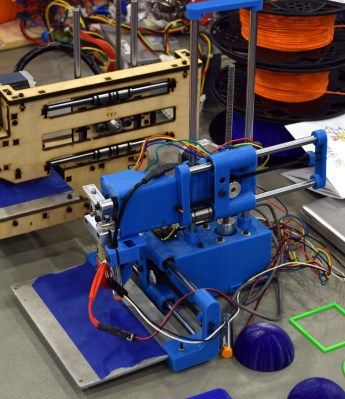By pretty much any metric you care to use, the inaugural East Coast RepRap Festival (ERRF) in 2018 was an incredible success. There was plenty to see, the venue was accommodating, and the ticket prices were exceptionally reasonable. But being a first-time event, there was an understandable amount of trepidation from both exhibitors and the attendees. Convincing people to travel hundreds of miles to an event with no track record can be a difficult thing, and if there was a phrase that would best describe the feel of that first ERRF, it would probably have been “cautious optimism”.
 But this year, now that they had some idea of what to expect, the 3D printing community descended on Bel Air, Maryland with a vengeance. In 2019, everything at ERRF was bigger and better. There were more people, more printers, and of course, more incredible prints. Activities like the 3D Printed Derby returned, and were joined by new attractions including full-body 3D scanning and a shooting gallery where attendees could try out the latest in printable NERF weaponry.
But this year, now that they had some idea of what to expect, the 3D printing community descended on Bel Air, Maryland with a vengeance. In 2019, everything at ERRF was bigger and better. There were more people, more printers, and of course, more incredible prints. Activities like the 3D Printed Derby returned, and were joined by new attractions including full-body 3D scanning and a shooting gallery where attendees could try out the latest in printable NERF weaponry.
The official tally shows that attendance nearly doubled over last year, and with growth like that, we wouldn’t be surprised if the ERRF organizers consider relocating to a larger venue for 2020 or 2021. As far as problems go, growth so explosive that it requires you to rethink where you hold the event isn’t a bad one to have. The Midwest RepRap Festival, which served as the inspiration for ERRF, found they too needed to move into more spacious digs after a few years. Something to keep in mind the next time somebody tells you the bubble has burst on desktop 3D printing.
Trying to distill an event as large and vibrant as ERRF 2019 into a few articles is always difficult. Even after spending hours walking around the show floor, you would still stumble upon something you hadn’t seen previously. As such, this article is merely a taste of what was on hand. The East Coast RepRap Festival 2020 should absolutely be marked on your calendar for next year, but until then let’s take a look at just some of what made this year’s event such a smash.
The Stars Were Shining
The terms “celebrity” and “additive manufacturing” may not immediately seem like they go together, but of course every community has its own unique collection of luminaries. One of the first and most obvious signs that ERRF had gained significant mindshare within the 3D printing sphere was just how many of them you could find roaming around.
Popular YouTube personalities such as the 3D Printing Nerd and 3DMN were on hand doing interviews with exhibitors, and Thomas Sanladerer even live streamed a walk-through of the event. While the first ERRF largely flew under the radar in terms of video coverage, this year it looks as though nearly every YouTube channel dedicated to 3D printing did some on location content. With an audience that numbers in the hundreds of thousands, it will be interesting to see what impact this additional exposure has on ERRF going forward.

The event also enjoyed the obviously increased confidence of its sponsors and vendors. Not only were there more sponsors this time around, but the ones returning from last year greatly increased their presence at the event. In 2018 the Prusa Research booth was little more than a few printers and example pieces, but this year not only was Josef Průša personally in attendance, but he also used the opportunity to officially unveil the new Prusa Mini.
But easily the biggest star of the show was Dr. Adrian Bowyer, the creator of the RepRap Project and arguably the “father” of desktop 3D printing as we know it today. During his standing-room only talk, Dr Bowyer explained how his lifelong obsession with self replicating machines lead to the first RepRap, and described a theoretical 3D printer that he’s been working on. The machine, which he stresses may ultimately prove impossible to build with current technology, would use an array of electrodes inside a vat of liquid to form three dimensional objects using finely controlled electrical current. Such a printer would do away with the traditional “layers”, and would polymerise the object as a whole over the course of a few seconds or minutes.
An Open Source Autosampler
One of the best things about events such as ERRF, especially for the type of people who read Hackaday, is seeing the incredible things people are building with 3D printed parts. While Prusa’s latest and greatest might have been drawing the largest crowd, some of the most fascinating pieces of engineering on display were those built by individual hackers.
Certainly one of the most impressive was the Open Source Laboratory Autosampler built by John Pickens. The machine is designed to help automate water testing by taking a carefully measured sample from up to 50 vials with a NEMA 17 powered syringe pump. John explained that while in use the entire machine would be placed inside of a temperature controlled enclosure, and that the serpentine conveyor was designed to maximize how many samples could fit into the chamber.
In total he estimates the cost to build one of these autosamplers to be around $2,500, which seems a lot until you find out that the commercial alternatives have at least an extra zero tacked onto that number. He’s still designing and documenting the build, but in the meantime he’s released the OpenSCAD files for the syringe pump on Thingiverse where he’s said there’s already been considerable interest.
Continuing the Adoptabot Dream

Shortly before the company’s demise last summer, PrintrBot founder and CEO Brook Drumm had been working on what he called the Adoptabot: an open source self-replicating printer that could be built for less than $100. Consisting almost entirely of 3D printed parts, Brook hoped that Adoptabots could be printed and assembled by volunteers and distributed to schools as an educational tool.
In the turmoil of the PrintrBot bankruptcy, the Adoptabot project understandably fell to the wayside. But not before a number of dedicated fans had started running off their own copies. Eventually this fledgling community of Adoptabot builders started comparing notes and proposing changes, and before long the diminutive printer started taking on a life of its own.
Joel C brought a couple of his evolved Adoptabots to ERRF, and while at this point the design is quite far removed from the spindly original version, they still use hardware salvaged from old PrintrBots and have the unmistakable cantilevered layout the company’s printers were known for. Joel said that in the future he plans on updating the design to support the more common E3D hotend and associated extruder for those who might not have a donor PrintrBot hanging around.
As they’re still intended for educational use, each axis of the machine is printed in a different color plastic so its motion can be more easily explained. The addition of aluminum extrusion should also make this new variant quite a bit stiffer and better suited to the rough handling it would likely encounter in a school environment. Joel has released the design of his “RGB4ZYX” Adoptabot as an OnShape project that anyone can view and study, and he told us that he plans on putting together a Hackaday.io page for the printer in the near future.
And Of Course, The Prints
While the talks, interviews, printers, and hardware projects on display were all fantastic, we couldn’t end this coverage of ERRF without a collection of some of the incredible 3D prints that were on display. Naturally we’re big fans of functional 3D prints that actually do something here at Hackaday (we even ran a contest for exactly that), but we have to admit that a few of the purely artistic creations were some of the most impressive things at the show.
The following gallery shows just a small sampling of the phenomenal feats of plastic that were on display at the 2019 East Coast RepRap Festival. If you’d like to see more, you’ll just have to get yourself to one of these events yourself: the 2020 Midwest RepRap Festival is only six months away.


































ERRF was a lot of fun this year. Seems like it might be bigger next year. We had our Autodrop3d table upstairs this year.
Damn that was a good article. It gave a good overview of the salient points. I was only there Saturday but you captured it.